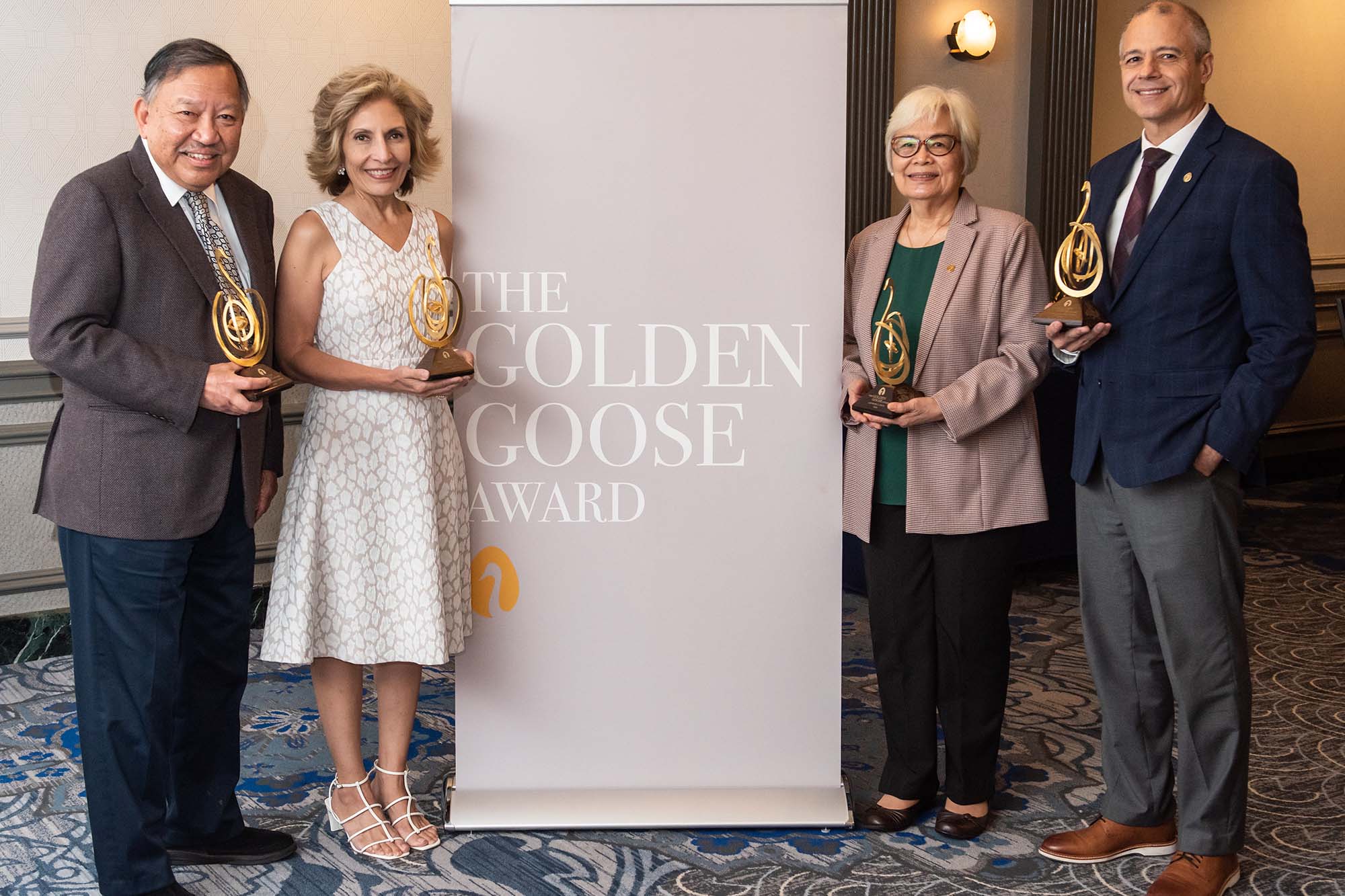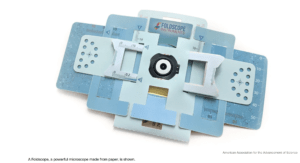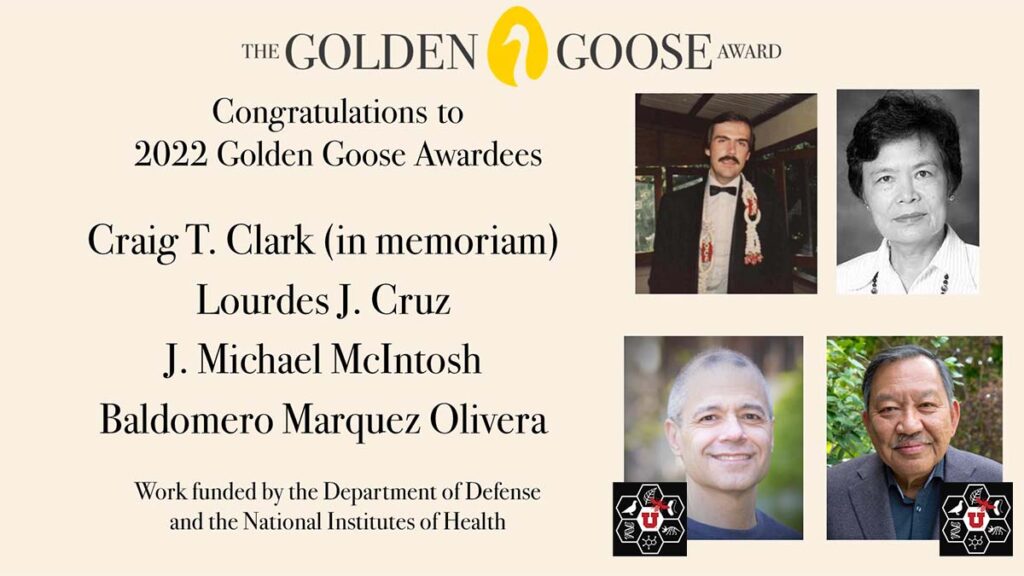
These scientific breakthroughs led to the development of a bladeless LASIK procedure, paper microscopes, and the discovery of a non-opioid pain reliever hidden in the venom of cone snails
WASHINGTON, D.C. – On September 14, 2022, the American Association for the Advancement of Science (AAAS), the world’s largest multidisciplinary scientific society, hosted the 11th annual Golden Goose Award ceremony, a celebration of federally funded research that unexpectedly benefits society. This year’s awardees, three international, multi-institutional teams, discovered:
- A novel approach to corrective eye surgery, bladeless LASIK is now considered the standard in the field and used by millions — resulting from an accidental laser injury.
- A way to construct a low-cost, high-performing paper microscope that scientists can use to diagnose diseases and expand science education in remote areas, making science accessible worldwide.
- A non-opioid pain reliever, hidden in the venom of tiny cone snails, which greatly decreases pain for patients with chronic illnesses while helping researchers develop new ways to map the body’s nervous system.
The third and final award is given for discoveries made by a team that included SBS’s Baldomero “Toto” Olivera and Michael McIntosh along with their colleagues Craig T. Clark (in memoriam) and Lourdes J. Cruz (University of the Philippines)
The Golden Goose Award spotlights scientific research that may have appeared obscure, sounded funny, or for which the results were unforeseen at the outset but ultimately, and often serendipitously, led to breakthroughs. This year, the award comes on the heels of the U.S. Congress passing and President Biden signing the bipartisan and historic CHIPS and Science Act. This new law reauthorizes key federal agencies whose projects will propel discovery, build on our strengths, and show what American investment, intellect, ingenuity and risk-taking can accomplish — precisely the type of innovation the Golden Goose Award honors.
“The Golden Goose Award reminds us that potential discoveries could be hidden in every corner and illustrates the benefits of investing in basic research to propel innovation,” said Sudip S. Parikh, chief executive officer at AAAS and executive publisher of the Science family of journals. “AAAS is honored to elevate this important work since the award’s inception, and we thank Representative Cooper for his tireless leadership and dedicated support to this award and the scientific community.”
U.S. Representative Jim Cooper (D-TN), often referred to as “Father Goose,” will retire from Congress at the end of this term. He conceived of the award as a strong counterpoint to criticisms of basic research as wasteful federal spending, such as the late Sen. William Proxmire’s (D-WI) Golden Fleece Award, leading to a coalition of business, university, and scientific organizations establishing the award in 2012. Thanks to his legacy, the award will continue to elevate the importance of recognizing basic science that ultimately improves people’s quality of life.
“It has been an honor to watch the Golden Goose Award grow over the past decade, while highlighting the stories of incredible scientists and innovators in a range of fields. Remarkable scientific discoveries – and the people behind them – are as important as ever. Congratulations to this year’s awardees,” said Cooper.
“For years, the Golden Goose Award has highlighted amazing breakthroughs in scientific research thanks to key federal investments. I am pleased to join the Golden Goose Award family this year and grateful for AAAS’ support for the CHIPS and Science Act. This historic investment in science and technology will bolster our national security and our economy,” said Senator Todd Young (R-IN), the newest member of the Golden Goose Award’s bipartisan group of congressional supporters.
This year’s awardees are:
Ron Kurtz (RxSight), Tibor Juhasz (ViaLase), Detao Du (Rayz Technologies), Gerard Mourou (Ecole Polytechnique), and Donna Strickland (University of Waterloo)
How a Lab Incident Led to Better Eye Surgery for Millions of People
Nearly 30 years ago, a graduate student at the University of Michigan’s Center for Ultrafast Optical Science (CUOS) experienced an accidental laser injury to his eye. Fortunately, his vision was not severely affected. However, the observation of the very precise and perfectly circular damage produced by the laser led to a collaboration. Eight years later, that group of researchers developed of a bladeless approach to corrective eye surgery. The new procedure, also known as bladeless LASIK, uses a femtosecond laser rather than a precision scalpel cut into the human cornea before it is reshaped to improve the patient’s vision.
Manu Prakash (Stanford University) and Jim Cybulski (Foldscope Instruments Inc.)
Foldscopes and Frugal Science: Paper Microscopes Make Science Accessible

While researching in remote areas of India and Thailand, a technical challenge piqued Manu Prakash’s curiosity. In certain areas of the world, transport, training, and maintenance barriers can make state-of-the-art microscopes inaccessible. Prakash found a potential solution in a decidedly un-technical material: paper. Using principles of origami applied to printer paper, matchboxes, and file folders, Prakash and graduate student Jim Cybulski designed a paper microscope known as the Foldscope that can achieve powerful magnification with materials that cost less than $1 to manufacture. Today, just over a decade later, two million Foldscopes have been distributed in over 160 countries and have been used to diagnose infectious diseases, diagnose new species, and identify fake drugs, among many other applications. The College of Science and SBS were thrilled to host Prakash at the Frontiers of Science lecture series. You can watch a video recording of it here. The Foldscoope has since been a handed out broadly by the College and U Biology as SWAG.
Craig T. Clark (in memoriam), Lourdes J. Cruz (University of the Philippines), J. Michael McIntosh (University of Utah; George E. Wahlen VA Medical Center), and Baldomero Marquez Olivera (University of Utah)
Olivera (University of Utah)
Tiny Snail, Big Impact: Cone Snail Venom Eases Pain and Injects New Energy into Neuroscience
Impeded by supply chain issues while conducting DNA research in the Philippines, Lourdes Cruz and Baldomero Olivera began examining cone snails, a group of highly venomous sea mollusks which happened to be in abundant supply along the country’s coastal waters. Several decades and countless airline miles later, and with the help of then-undergraduate students Craig Clark and Michael McIntosh, the team discovered the raw material for a non-opioid pain reliever and a powerful new tool for studying the central nervous system, all hidden in the cone snail’s potent venom.
The Golden Goose Award is pleased to welcome several new sponsors this year, including Wiley, a global publishing company supporting researchers to communicate discoveries that make a difference, and Google.
The SBS community gathered in the afternoon of Sept. 14 on campus to witness together the festivities from Washington via Livestream.
Read more about the Olivera lab’s work and its recent capture of the 2022 Golden Goose Award here.
Also a story by LISA POTTER | adapted from an AAAS press release with content from history written Terry Merritt, Assistant to Dr. Olivera here.
